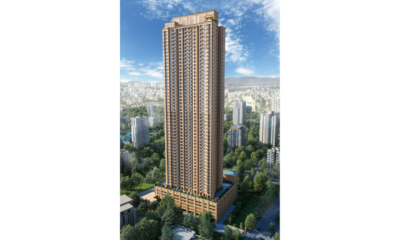Guest Column
Consumer demand Epicentre of growth


By Niranjan Hiranandani – National President, Naredco
Indian real estate has reflected resilience against tide in times due to the unprecedented COVID-19 pandemic crisis. The pandemic has underlined the worth of owning a home on parameters of safety and security and keeping the pace to adapting to a new normal routine that encompasses work or study from home culture.
The pandemic-led disruption has changed the way of living and real estate has been on the top of the mind for the consumers; be it an end-user or investors looking out safe bet options to park funds. Though, the fiscal stimulus and policy interventions by the Government and RBI have provided impetus to the ailing real estate sector, it is renewed consumer demand that has come to its salvage.
Consumer demand has undergone a radical shift post-COVID, in order to tally with the new normal cultural shift. The new set of preferences has surfaced which has pushed the planning and designing back to the drawing board. The consumer choices are evolving dynamically in terms of the preferred amenities and facilities. Innovative measures are being adopted in accordance with physical distancing norms by designing efficient home layouts, sanitisation that meets hygiene and wellness protocols and offers technology enabled lifestyle.
The market is witnessing a surge in demand for spacious homes that offer flexi space to indulge in individual choice of activities supplemented with smart modular furniture, ample open space and good ventilation that befits the new normal routine of work\study\wellness\fitness at home culture. There has been demand to set up a business centre with in the residential cluster that offers walk to work environment
The change in consumer demand is largely about ensuring aspects that spell ‘safety’ as an integral part of the new home as follow-
Security amenities– Security station at building entrance – temperature monitoring, geo- check in for visitors, markers on ground surfaces to ensure social distancing norms are followed at checkpoints.
Healthcare amenities– Foot press pedal for sanitiser, footwear spray machine, foot pedal door opener (instead of using door handles, automatic door opener mechanism with motion sensor are the examples of hygiene oriented facilities to be incorporated at multiple touch points. Also, need of small healthcare clinic in close proximity is preferred
Technology measures – Smart home facilities with reliable and hyper scalable internet connectivity on fibre, wireless-enabled homes, IoT-based device management, lighting management , curtain controls, automations based on mobile phones , voice based (Google Home, Alexa), automated parking management system, electric vehicle charging system etc are new futuristic choices.
The beleaguered real estate sector faces challenges in terms of liquidity and labour which needs acute attention from higher authorities. While, overall economic booster dose augurs well with recalibrated opening of the economy, the sector seeks specific measures aimed to resolve underlying challenges. Policy innovations have enabled credit supply back in the market to roll out the stalled production and engage the local labour available, meanwhile efforts are ongoing to retrieve migrant labour force. Industry may face challenges in procuring sufficient raw materials at an affordable price which may lead to some delay in deliverables. Companies are also required to incorporate technological tools to expedite the work and meet the backlog, but may face some glitches and financial constraint for the tech-driven investment in the current scenario. But, as the known fact that every challenge opens the new door of opportunities, the same applies in the stressed real estate sector.
Renewed consumer demand in backdrop of favourable market conditions like historic low interest rate, lower stamp duty, low risk weight age, available of good deals, festive offers, flexi payment schemes and cherry picking of homes rekindles the demand, enhancing the market sentiments which translate into an uptick in sales momentum. Ready-to-move-in properties gain cutting edge over the under-construction as time is ripped to buy or invest in real estate. As the values of other investment instruments have blown away due to volatility, real estate emerged as a safe bet option. Indian real estate has undergone a system reboot after Tsunami hits in the form of policy reforms like RERA, IBC and GST that had lasting rippling effects. But, as we see economic resilience and growth projector turning to an optimistic zone, Indian real estate is set to rebound exponentially with Housing for all being the New Normal trend.
The industry has been facing the liquidity crunch for the longest time which turned many positive net worth companies negative making it a NPA. Here, Banks, NBFC, financial institutions and housing finance companies play a crucial role in ensuring easy credit supply at lower cost to resuscitate the stalled projects. Availability of a stress fund to facilitate last mile funding along with one time debt rollover will go a long way in resurrecting a negative balance sheet and fast track the stalled projects. The enhanced credit flow will meet the working capital needs and set the ball rolling.
Regulatory authorities, including RERA and IBC, have given timeline in wake of pandemic events. In the scenario where real estate is rebooting after the series of lockdowns, it faces challenges of labour shortage, supply chain disruption as also sweeping changes in business practices and consumer trends. Time line extension for the longer gestation period will enable elbow room for quick recovery, while perhaps, suspending some regulatory aspects for a year would be a major help.
Industry pegs high hopes that regulatory authorities will take a holistic view and ensure that the industry is able to recoup the losses and regain the growth trajectory.
-



 Interviews4 weeks ago
Interviews4 weeks agoHigh Rental Yield, Price Appreciation, Stable Growth, Make Sydney an Ideal Realty Investment Option: Haansal Estate
-



 News3 weeks ago
News3 weeks agoManasum Senior Living Launches IKIGAI GOA, A Senior Living Community in North Goa, in collaboration with Prescon Homes
-



 News2 weeks ago
News2 weeks agoKW Delhi 6 Mall Onboards New Brands
-



 News1 week ago
News1 week agoGodrej Properties Sells Rs 3k cr+ Homes of Godrej Zenith, Gurugram, within 3 days
-



 News3 weeks ago
News3 weeks agoBridging India Divide: Top 5 Tier- 2 Cities to Focus On
-



 News2 weeks ago
News2 weeks agoCommercial Realty Gets Tech Savvy: Fast Construction, Enhanced Convenience
-



 News3 weeks ago
News3 weeks agoMultipoint Connection – A Definite Boon
-





 News2 weeks ago
News2 weeks agoRBI’s Status Quo on Key Policy Rates to Help Maintain the Real Estate Growth Momentum, Say Industry Stalwarts



























